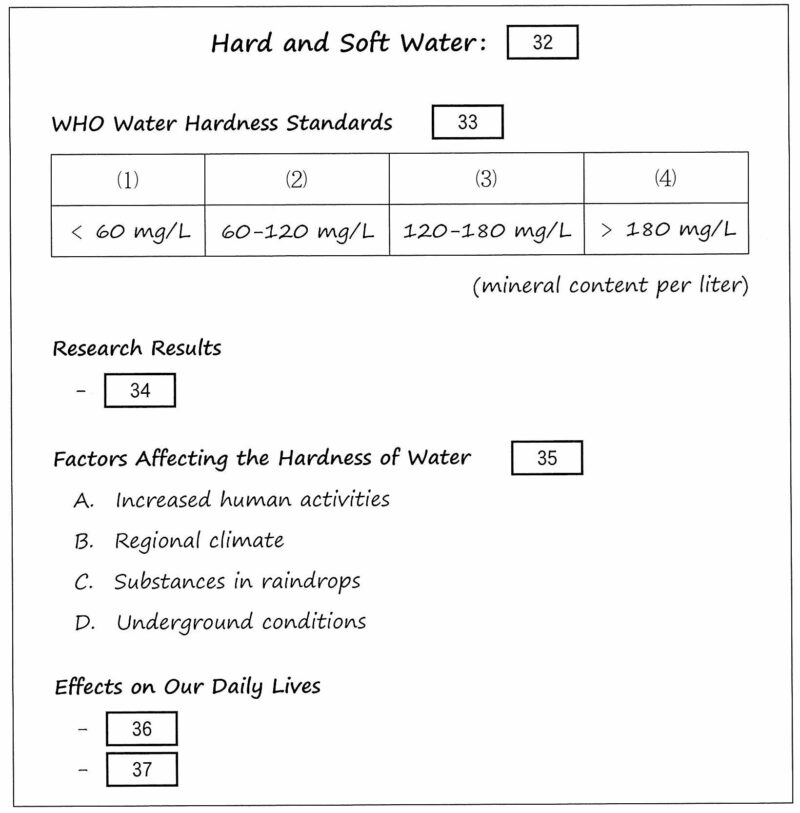2025年度の大学入学共通テスト追試験英語第7問の解説をしています。疑問点が残らないよう、解き方の手順も踏まえて一問一問どこよりも丁寧に説明します。
問題
You are preparing a presentation for science class. You found some interesting information in the article below and are now making your outline.
Hard and Soft Water
Every day water flows through the pipes in our homes. It is used for bathing, cooking, and many other things. Although water is a liquid which does not appear to be hard, there are actually different degrees of hardness or softness. In fact, there are distinct differences in the makeup of water, how it becomes hard or soft, and suitable uses for each type.
Natural water in the form of rain or snow is soft. Water becomes hard when it absorbs calcium, magnesium, or small amounts of iron. According to the World Health Organization (WHO), water containing 60 or more milligrams of these minerals per liter (mg/L) is generally considered hard water. This “hard water” can be further subdivided. Water containing 60-120 mg/L is moderately hard, and water containing 120-180 mg/L is hard. If water contains more than 180 mg/L, it is classified as very hard. In contrast, water with low mineral content (below 60 mg/L) is said to be soft. Scientists explain that mineral content in water varies by location. Researchers at the University of Tokyo, comparing water in Japan with that of 27 other countries from 2017 to 2020, determined that Japanese water was considered to be on the soft side, whereas water in parts of Europe and Africa tended to be harder. The researchers found that water hardness depended more on the quality of the raw, or unpurified, water than the purification process or the pipes used for its transportation.
There are several variables affecting the mineral content of raw water. These include the kinds of rock in the ground, the amount of rain or snow that falls in a region, and urbanization. Areas where water is taken from underground sources have harder water because it has passed through rocks containing minerals that dissolve in it. In addition, place where there is a lot of snow have softer water, especially when it melts in spring. The movement of more people and industries into cities, as well as the infrastructure such as roads and buildings to support them, also affects the mineral content of the water.
Since the properties of hard and soft water differ, each type has different uses. The minerals in hard water make it more difficult for soaps and detergents to form lather. These soapy bubbles don’t wash away easily and can leave a thin film of soap on the skin or hair. The minerals may also leave white spots on glasses, cutlery, or shower mirrors. Limescale, a hard white substance, might restrict water flow in pipes and discolor or damage appliances as well. Despite these negative aspects, hard water tends to rate higher on taste tests and could be beneficial for our health because it boosts our daily mineral intake.
If the water we use at home is soft, it could save us money. We will use less water and electricity for cleaning because soap rinses out more efficiently. Our clothes will also be cleaner and last longer because minerals in hard water make them wear out more quickly. When tap water is hard, it can be softened at home using special devices attached to a house’s water system. These devices remove minerals by filtering water through beads with positively changed potassium ions. These ions attract the minerals, removing them from the water. However, this process could make the treated water saltier than before.
If water filtration systems are too costly to buy and maintain, there are home remedies that can help solve hard water problems. Boiling water removes the minerals, which is useful when smaller amounts of soft water are needed. White vinegar and baking soda both react to and neutralize calcium and other minerals in water. Therefore, these products are good cleaning or washing supplements when you have hard water at your home.
Now that we know the differences between hard and soft water, perhaps an ideal mix of the two is best for our daily lives.
Your presentation outline

問1 You are going to add details to your presentation title. Choose the best option for ( 32 ).
- Advantages and Disadvantages for Health
- Characteristics, Sources, and Daily Uses
- Ingredients, Cleaning Systems, and Consumption
- Locations, River Types, and Possible Problems
問2 Choose the best option to complete the table in the outline.
| 1. | (1) Soft Water (3) Moderately Hard Water | (2) Hard Water (4) Very Hard Water |
| 2. | (1) Soft Water (3) Hard Water | (2) Moderately Hard Water (4) Very Hard Water |
| 3. | (1) Very Soft Water (3) Soft Water | (2) Moderately Hard Water (4) Hard Water |
| 4. | (1) Very Soft Water (3) Moderately Hard Water | (2) Soft Water (4) Hard Water |
問3 Choose the best option for ( 34 ).
- It was difficult to determine the regional differences of water hardness.
- Japanese water was the hardest among all of the countries studied.
- Regional water hardness was affected by the quality of raw water.
- The power of purification plants in Europe was different from Japan.
問4 Under the heading, “Factors Affecting the Hardness of Water,” you spotted an error in your presentation outline. Which of the following should you remove?
- A
- B
- C
- D
問5 Choose the best options for ( 36 ) and ( 37 ).
- Hard water can completely get rid of a soapy film.
- Home remedies are ineffective for softening water.
- Minerals in hard water can positively affect our health.
- Soft water can help reduce household energy cost.
- Water spots are effective for improving appliance use.
解説 問1
You are going to add details to your presentation title. Choose the best option for ( 32 ).
プレゼンテーションのタイトルに詳細を追加します。( 32 )に最適な選択肢を選んでください
選択肢を確認しましょう。
1. Advantages and Disadvantages for Health
健康への利点と欠点
2. Characteristics, Sources, and Daily Uses
特徴、原因、日常的な使用
3. Ingredients, Cleaning Systems, and Consumption
成分、洗浄システム、消費
4. Locations, River Types, and Possible Problems
場所、川の種類、起こりうる問題
第一段落にこうあります。
Although water is a liquid which does not appear to be hard, there are actually different degrees of hardness or softness. In fact, there are distinct differences in the makeup of water, how it becomes hard or soft, and suitable uses for each type.
水は一見硬そうに見えない液体ですが、実際には硬度や軟度が異なります。実際、水の種類によって、どのように硬くなったり軟らかくなったりするか、そしてそれぞれに適した用途が明確に異なります。
水には硬度や軟度が異なるという「Characteristics / 特徴」があり、どのように硬くなったり軟らかくなったりするかの「Sources / 原因」と、それぞれに適した「Daily Uses / 日常の使用」方法について、この記事は説明しています。
ということで、正解は「2」です。

むしろこれは消去法でする方がやりやすいかもしれませんね。タイトル関連の問題なので、一番最後に取り組むのもありです。
解説 問2
Choose the best option to complete the table in the outline.
アウトラインの表を完成させるには、最適な選択肢を選んでください
アウトラインの表はこれです。

この(1)~(4)に入るのは何かという問題です。
第二段落にこうあります。
Water containing 60-120 mg/L is moderately hard, and water containing 120-180 mg/L is hard.
60~120 mg/L の水は moderately hard、120~180 mg/L の水は hard です。
(2)が「Moderately Hard Water」、(3)が「Hard Water」です。
If water contains more than 180 mg/L, it is classified as very hard.
180 mg/L を超える水は、very hard に分類されます。
(4)が「Very Hard Water」です。
In contrast, water with low mineral content (below 60 mg/L) is said to be soft.
一方、ミネラル含有量が少ない水 (60 mg/L 未満) は soft と呼ばれます
(1)が「Soft Water」です。
ということで、正解は「2」です。

60 mg/L 以上が「hard water」で、その「hard water」をさらに細かく分類するとどうなるかという話でしたね。
解説 問3
Choose the best option for ( 34 ).
( 34 )に最適な選択肢を選んでください
( 34 )はアウトラインの「Research Results / 調査結果」の項目にあります。選択肢を確認しましょう。
1. It was difficult to determine the regional differences of water hardness.
水の硬度の地域差を判断するのは困難でした。
東京大学の研究者が、水の硬度の地域差を調べました。しかしその判断が困難という話はありません。この選択肢は違います。
2. Japanese water was the hardest among all of the countries studied.
日本の水は調査対象となったすべての国の中で最も硬かったです。
第二段落にこうあります。
Researchers at the University of Tokyo, comparing water in Japan with that of 27 other countries from 2017 to 2020, determined that Japanese water was considered to be on the soft side, whereas water in parts of Europe and Africa tended to be harder.
東京大学の研究者は、2017年から2020年にかけて日本の水と他の27か国の水を比較し、日本の水は軟水であると考えられているのに対し、ヨーロッパやアフリカの一部の水は硬水である傾向があることを突き止めました。
日本の水は「軟水」です。この選択肢は違います。
3. Regional water hardness was affected by the quality of raw water.
地域の水の硬度は、原水の品質によって影響を受けました。
第二段落にこうあります。
The researchers found that water hardness depended more on the quality of the raw, or unpurified, water than the purification process or the pipes used for its transportation.
研究者は、水の硬度は、浄水プロセスや輸送に使用されるパイプよりも、生の水、つまり未浄化の水の品質に大きく左右されることを発見しました
水の硬度は「生の水」に影響されます。この選択肢が正解です。
4. The power of purification plants in Europe was different from Japan.
ヨーロッパの浄水場の能力は日本とは異なっていました。
そのような記述はありません。この選択肢は違います。
ということで、正解は「3」です。

第二段落の中盤に、東京大学の研究者が調査を行っていますので、そこがこの問題の該当部分だと判断できます。
解説 問4
Under the heading, “Factors Affecting the Hardness of Water,” you spotted an error in your presentation outline. Which of the following should you remove?
「Factors Affecting the Hardness of Water / 水の硬度に影響を与える要因」という見出しの下で、プレゼンテーションのアウトラインに誤りを見つけました。次のどれを削除する必要がありますか
「Factors Affecting the Hardness of Water / 水の硬度に影響を与える要因」の下にある項目を確認しましょう。
A. Increased human activities
人間の活動の増加
B. Regional climate
地域の気候
C. Substances in raindrops
雨滴中の物質
D. Underground conditions
地下の状態
第三段落にこうあります。
There are several variables affecting the mineral content of raw water. These include the kinds of rock in the ground, the amount of rain or snow that falls in a region, and urbanization.
生水のミネラル含有量に影響を与える変数はいくつかあります。これには、地中の岩の種類、地域に降る雨や雪の量、都市化が含まれます。
「地中の岩の種類」は「D」の「地価の状態」、「地域に振る雨や雪の量」は「B」の「地域の気候」、「都市化」は「A」の「人間の活動の増加」にあたります。
「C」の「雨滴中の物質」については、第二段落にこうあります。
Natural water in the form of rain or snow is soft.
雨や雪などの天然水は軟水です
雨はミネラルを含まないため軟水です。「雨滴中の物質」が水の硬度に影響を与えるようなことはありません。つまり削除する必要があるのは「C」です。
ということで、正解は「3」です。

道路や建物も水の硬度に影響を及ぼすんですね。言われてみれば納得ですが、面白いです。
解説 問5
Choose the best options for ( 36 ) and ( 37 ).
( 36 )と( 37 )に最適な選択肢を選んでください
( 36 )と( 37 )はアウトラインの「Effect on Our Daily Lives / 日常生活への影響」の項目にあります。選択肢を確認しましょう。
1. Hard water can completely get rid of a soapy film.
硬水は石鹸膜を完全に取り除くことができます。
第四段落にこうあります
The minerals in hard water make it more difficult for soaps and detergents to form lather. These soapy bubbles don’t wash away easily and can leave a thin film of soap on the skin or hair.
硬水に含まれるミネラルにより、石鹸や洗剤が泡立ちにくくなります。これらの石鹸の泡は簡単に洗い流されず、肌や髪に石鹸の薄い膜を残すことがあります。
硬水は石鹸膜を残してしまうことがあります。完全に取り除くことができるわけではありません。この選択肢は違います。
2. Home remedies are ineffective for softening water.
家庭療法は水を軟化させるのに効果がありません。
第六段落にこうあります。
If water filtration systems are too costly to buy and maintain, there are home remedies that can help solve hard water problems.
浄水システムの購入と維持に費用がかかりすぎる場合は、硬水の問題を解決するのに役立つ家庭療法があります。
沸騰させたり、ホワイトビネガーや重曹で中和させたりすることで、水を軟化させることができます。この選択肢は違います。
3. Minerals in hard water can positively affect our health.
硬水に含まれるミネラルは、私たちの健康に良い影響を与える可能性があります。
第四段落にこうあります
Despite these negative aspects, hard water tends to rate higher on taste tests and could be beneficial for our health because it boosts our daily mineral intake.
これらのマイナス面にもかかわらず、硬水は味覚テストで高い評価を受ける傾向があり、毎日のミネラル摂取量を増やすため、健康に良い可能性があります。
硬水はミネラルが摂取できるので、健康に良い可能性があります。この選択肢が正解です。
4. Soft water can help reduce household energy cost.
軟水は、家庭のエネルギーコストを削減するのに役立ちます。
第五段落にこうあります。
If the water we use at home is soft, it could save us money.
家庭で使用する水が軟水であれば、お金を節約できます。
軟水は石鹸のすすぎが効率的になったり、衣類が長持ちしたりします。この選択肢が正解です。
5. Water spots are effective for improving appliance use.
ウォータースポットは、電化製品の使用を改善するのに効果的です。
第四段落にこうあります
Limescale, a hard white substance, might restrict water flow in pipes and discolor or damage appliances as well.
硬い白い物質である石灰は、パイプ内の水の流れを妨げ、家電製品を変色させたり損傷させたりすることがあります。
ウォータースポットが家電製品を変色させたり損傷させたりすることがあります。この選択肢は違います。
ということで、正解は「3」と「4」です。

洗い物には軟水がいいんですね。勉強になりました。



コメントをどうぞ